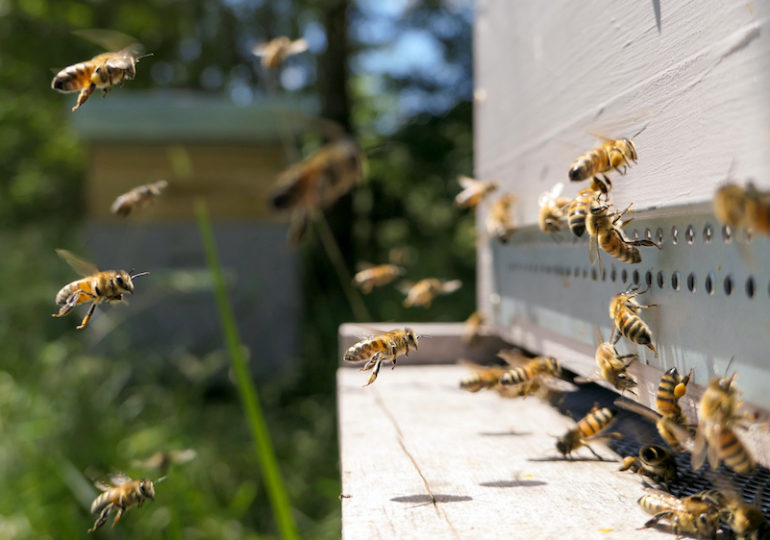 Véto-pharma
Véto-pharma Summary of the scientific publication “Sublethal fluvalinate negatively affects the development and flight capacity of honeybee (Apis mellifera L.) workers” by Wu, Xiaobo, et al., 2022.

As one of the most-used molecules to combat varroa (Varroa destructor) infestation since the 1980s, (tau-)fluvalinate has been researched intensively with regards to its efficacy, toxicity, and its overall effects on varroa mites as well as honey bee (Apis mellifera) colonies. While fluvalinate has demonstrated high efficacy against the mite initially, extensive use quickly led to problems, with resistance developing against the molecule in many varroa populations.1-2 As a suspected contributing factor to quick resistance development in varroa, high residue levels, especially in worker bees and in honey, have been detected.3-4
In recent years, several publications have reported different negative effects of sublethal doses of fluvalinate such as a reduced queen survival rate5, reduced body weight, and disturbance of drone development in honey bee colonies6. While data collected on potential risks of fluvalinate use against varroa mites have provided valuable insights in the past, other important aspects, as for example the molecule’s potential influence on worker bee flight behavior and homing rate had not been investigated previously.
In the article “Sublethal fluvalinate negatively affects the development and flight capacity of honeybee (Apis mellifera L.) workers”, published earlier this year, the authors describe how sublethal fluvalinate exposure during larval development affects the homing ability and number of lifetime trips of worker bees.7 The researchers fed honey bees, ranging in age from 2-day-old larvae to 7-day-old adult worker bees, with varying concentrations of fluvalinate (0, 0.5, 5 and 50 mg/kg). Effects on larval development were recorded and all treated bees were released back into their colonies of origin.7
As a next step, the homing ability of 20-day-old worker bees at a distance of 1000 m and 2000 m from their hives was investigated, using radio frequency identification (RFID).
Bees that had been fed with a concentration of 5 mg/kg fluvalinate during development achieved a significantly reduced homing rate at a distance of 2000 m from the colony compared with the negative control group.
The cells of larvae that had been fed 50 mg/kg fluvalinate showed a reduced proportion of capped cells. Worker bees which developed out of these cells later demonstrated a reduced foraging time and homing rate as well as a significantly longer homing time. As soon as the fluvalinate exposure during larval development exceeded 5 mg/kg, a relatively low dose compared with residues found in honey samples in previous studies, bees seem to be unable to detoxify the higher amounts of fluvalinate.7
These results show that realistic fluvalinate residue levels of a similar quantity that has previously been detected in hive products may negatively affect the ability of honey bee colonies to build up resources and feed itself. Further investigations in this direction may clarify the potential impact of the reported effects on the amount of resources stored and implications for colony health and survival.
VTP-116-US-N01-05/23
1- Milani, Norberto. “The resistance of Varroa jacobsoni Oud. to acaricides.” Apidologie 30.2-3 (1999): 229-234.
2- Elzen, Patti J., et al. “Detection of resistance in US Varroa jacobsoni Oud.(Mesostigmata: Varroidae) to the acaricide fluvalinate.” Apidologie 30.1 (1999): 13-17.
3- Balayannis, P. G., and L. A. Santas. “Dissipation of malathion and fluvalinate residues from honey.” Journal of Apicultural Research 31.2 (1992): 70-76.
4- Bulletin technique ADA AURA 2016, édition Mars 2017. Des symptômes sur couvain aux résultats d’analyses toxicologiques. Etude menée en laboratoire afin de comparer des échantillons de cire provenant de cadres « sains » (n = 26) et de cadres « symptomatiques » (n= 28). Recherche de 173 pesticides et de 10 molécules (substances adultérantes et acaricides spécifiques).
5- Haarmann, Timothy, et al. “Effects of fluvalinate and coumaphos on queen honey bees (Hymenoptera: Apidae) in two commercial queen rearing operations.” Journal of economic entomology 95.1 (2002): 28-35.
6- Rinderer TE., De Guzman LI., Lancaster VA., Delatte GT., Stelzer JA. 1999. Varroa in the mating yard: 1. the effects of Varroa jacobsoni and Apistan on drone honey bees. American Bee Journal 139: 134-139.
7- Wu, Xiaobo, et al. “Sublethal fluvalinate negatively affect the development and flight capacity of honeybee (Apis mellifera L.) workers.” Environmental Research 203 (2022): 111836.